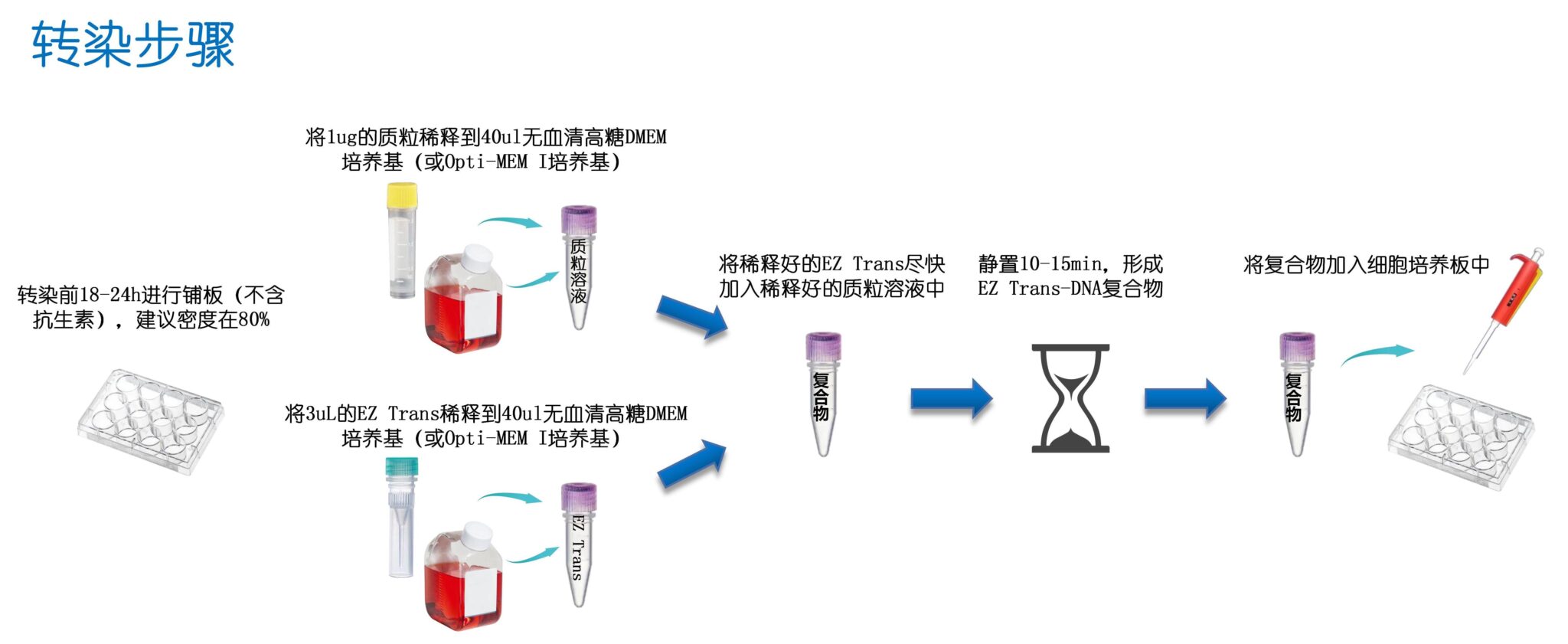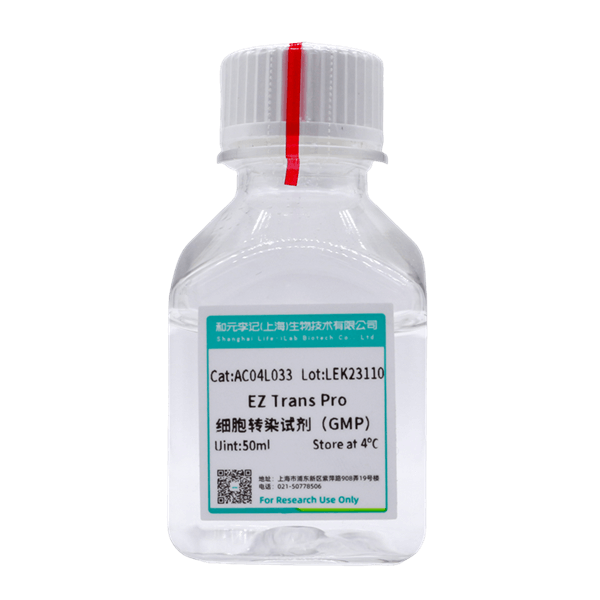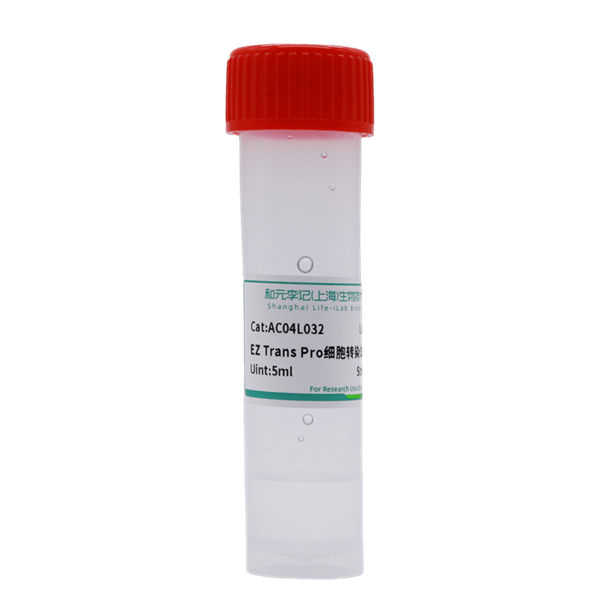Product Description
EZ Trans Pro Cell Transfection Reagent (GMP), as a new generation transfection reagent, operates by forming a positively charged complex between a cationic polymer and a negatively charged phosphate group in nucleic acid, which then interacts with negatively charged proteoglycans on the cell surface and enters the cell through endocytosis.
This product has been optimized by Li Ji Biotechnology and has the characteristics of high transfection efficiency, low cytotoxicity, simple operation, good repeatability, and wide applicability.
Product components
Product Name | Specifications |
EZ Trans Pro Cell Transfection Reagent (GMP) | 5 mL |
EZ Trans Pro Cell Transfection Reagent (GMP) | 50 mL |
EZ Trans Pro Cell Transfection Reagent (GMP) | 500 mL |
Transportation and storage
Blue ice transportation. Stored at 4 ℃, with a shelf life of 12 months. [Note]: Cannot be frozen!
usage method

This product is only for scientific experimental research and should not be used in clinical diagnosis, treatment, or other fields.
Fill in the product batch number for querying
Fill in the product batch number for querying
[{"text1":"The cells we transmit contain antibiotics. Will antibiotics absolutely affect the transfection efficiency?","text2":"Try not to add antibiotics as much as possible. In theory, antibiotics cannot enter cells, but under the action of transfection reagents, the permeability of cells increases, and antibiotics may enter cells, affecting the experimental results."},{"text1":"The protocol proposes to use Opti MEM extract and avoid adding antibiotics as much as possible. In theory, antibiotics cannot enter cells, but under the action of transfection reagents, the permeability of cells increases, and antibiotics may enter cells, affecting experimental results. Transfection reagent. Can't it be diluted with 1640? Why do plasmids and transfection reagents need to be diluted first and then mixed? Can't the transfection reagent be directly added to the plasmid solution and mixed, and then diluted with culture medium?","text2":"EZ Trans cell transfection solution belongs to the cationic type of transfection reagent, which requires certain conditions to form complexes with DNA. At an appropriate concentration, it is beneficial for cations to encapsulate DNA and form well shaped complexes that enter cells. If the two are directly mixed, they can easily form a polymer with diverse aggregation phases, which may expose DNA on the surface and make it difficult for it to enter cells, thereby reducing transfection efficiency. So the mixed sequence of EZ Trans and DNA is also important. Most cell cultures use fetal bovine serum, which has complex components that no one can explain in terms of composition and content. The composition of the cell transfection solution is relatively clear, but it cannot be determined whether it will bind to unknown components of fetal bovine serum. In fact, this phenomenon can cause adverse effects in most transfection reagents, so the influence of serum should be avoided during the formation of EZ Trans DNA complexes."},{"text1":"The protocol mentions that \"detecting transfection efficiency within 24-48 hours\" refers to the 24-48 hours after removing the culture medium containing the complex and replacing it with a culture medium containing serum, or does it refer to the 24-48 hours after adding the complex and transfection?","text2":"All times are counted from the contact between EZ Trans DNA complex and cells."},{"text1":"Low transfection efficiency - no efficient DNA transfection reagent complex was generated","text2":"Do not use products containing serum when preparing DNA transfection reagent complexes. In most cases, efficient DNA transfection reagent complexes can be obtained using serum-free DMEM culture medium. We recommend using a serum containing medium for transfection, and the single host nan complex must be formed in serum-free medium. Attention: It is best to avoid Opti MEN culture medium even if its serum content is low."},{"text1":"Low transfection efficiency - there are inhibitors that inhibit the formation of DNA transfection reagent complexes during the process of generating DNA transfection reagent complexes","text2":"Serum free culture medium is crucial for the formation of efficient DNA transfection reagent complexes. During the process of generating complexes, avoid using high concentrations of phosphates, chondroitin sulfate, hyaluronic acid, dextran sulfate, or other sulfated proteoglycans."},{"text1":"Low transfection efficiency - The transfection reagent complex contains serum","text2":"When preparing DNA capture reagent complexes, please use serum-free medium or Opti MEM culture. In most cases, using serum-free DMEM medium can obtain DNA transfection reagent complexes with improved efficiency."},{"text1":"Low transfection efficiency, high cytotoxicity - cell density not optimized","text2":"During DNA transfection and DNA siRNA co transfection, the cell density is controlled between 60% -70%; During siRNA transfection, the cell density is controlled at around 50%."},{"text1":"How to determine the transfection efficiency of the experiment?","text2":"It is recommended to set a positive control, such as green fluorescent protein (GFP), for each transfection."},{"text1":"Low transfection efficiency - leaving the transfection complex at room temperature for a long time","text2":"The EZ Trans cell transfection reagent should be stored at 4 \u2103. The optimal placement reagent and temperature for transfection complexes are 10-20 minutes at room temperature. Prolonged placement can significantly reduce transfection efficiency, so it is important to control the placement time within 20 minutes."},{"text1":"Low transfection efficiency - High speed centrifugation transfection complex","text2":"When forming transfection complexes, the standard operating procedure recommends vortex mixing transfection reagents and DNA or siRNA within a few seconds to produce efficient transfection complexes. If you want to centrifuge the composite adhered to the pipe wall, be sure to use extremely low speed centrifugation, such as 80g centrifugation for 5 seconds."},{"text1":"High cytotoxicity - excessive use of DNA","text2":"Suggest drawing a dose-response relationship curve to determine the optimal amount of DNA used."},{"text1":"High cytotoxicity - too much transfection reagent used","text2":"Suggest drawing a dose-response relationship curve to determine the optimal transfection reagent dosage."},{"text1":"High cytotoxicity - poor cell state during transfection","text2":"The transfection efficiency of EZ Trans cell transfection reagent is not affected by the serum in the culture medium. Therefore, it is recommended to use a complete culture medium containing 10% fetal bovine serum and antibiotics during the transfection process to improve the cell state."},{"text1":"High cytotoxicity - antibiotics added too early during stable transfection","text2":"Please add the selected antibiotics 48 hours after transfection"}]














 Back
Back
 Back
Back






























